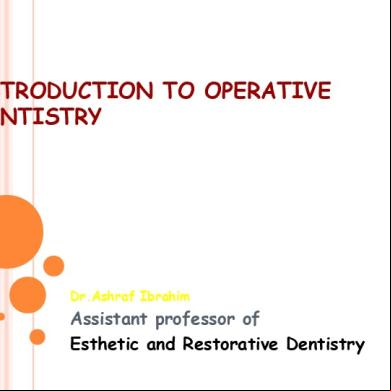4-introduction To Operative Dentistry-1 (1)-2 (1) m5557
This document was ed by and they confirmed that they have the permission to share it. If you are author or own the copyright of this book, please report to us by using this report form. Report 445h4w
Overview 1s532p
& View 4-introduction To Operative Dentistry-1 (1)-2 (1) as PDF for free.
More details 6h715l
- Words: 478
- Pages: 27
INTRODUCTION TO OPERATIVE DENTISTRY
Definition • It is the art and science of diagnosis, treatment, and
prognosis of defects of teeth that do not require full coverage restoration
• Operative Dentistry also known as Restorative Dentistry
or Conservative Dentistry.
Purposes of operative dentistry: 1.
Proper diagnosis
2.
Prevention of disease recurrence
3.
Interception ( prevent further loss of tooth structure)
4.
Preservation of the vitality of the tooth
5.
Restoration of tooth form, function, phonetics, and esthetics
Factors affecting operative treatment • There
are
two
main
factors
affecting
treatments:I.
Indications for treatment
II.
Consideration before any operative treatment
operative
1-Indications for operative treatment Dental caries Malformed, discolored, no esthetic, or fractured tooth
Restoration replacement or repair
2-Consideration before operative treatment 1)
An understanding of infection control measures
2)
Examination of oral and systemic health , not only the affected tooth
3)
Proper diagnosis and treatment plan for the dental problem
4)
An understanding of the used materials
5)
An understanding of the oral environment
6)
The
biological
function
of
the
components and ing tissues 7) Knowledge of correct dental anatomy
8) The effect of operative procedure
various
tooth
Dental caries • Def:
It is microbial infectious disease , characterized by demineralization and destruction of the tooth • Clinical sites: 1. Pit and fissures 2. Smooth surface 3. Root surface
Classification of dental caries According to location 1. 2. 3.
1. 2. 3.
Pit and fissure caries Smooth surface caries Root caries According to the affected tissues Enamel caries Dentinal caries Cementum caries
According to rate of progression 1.
Acute: quickly developing
2.
Chronic: taken an extended period
3.
Arrested: remineralized before causing cavitations
4.
Secondary or recurrent: on the margins of fillings
5.
Incipient caries: initial caries
G.V.Black’s classification of caries lesions class
Affected site
Class I
Occlusal areas and buccal or lingual pits
Class II
Posterior interproximal
Class III
Anterior interproximal
Class IV
Anterior interproximal including the incisal corner
Class V
Cervical (gingival) areas at facial or lingual
Class VI
Cusp tip
Etiology of dental caries • Dental caries is a multi-factorial disease occurs due to
interaction of 1.
Tooth surfaces
2.
Caries causing bacteria
3.
Substrate (diet) With time sequence
Tooth surface
caries Diet
Bacteria
MALFORMED , DISCOLORED, OR FRACTURED TEETH •
• MALFORMED TEETH
DISCOLORED TEETH
RESTORATION REPLACEMENT OR REPAIR
Teeth preparation • Objectives:1.
Remove all defects and provide protection to the pulp
2.
Conservative extension to the restoration
3.
Protect tooth and restoration from fracture under force of mastication
4.
Esthetic and functional placement
Stages of tooth preparation: Gaining access Removal of caries Development of final form Choice of restorative material Planning of retentive form
OPERATIVE PROCEDURES Procedures commonly done are: • Direct Restorations
• Indirect restoration • Veneers
DIRECT RESTORATIONS: Amalgam
Composite resin
GIC (Glass ionomer cement).
INDIRECT RESTORATIONS :
. Inlay
. Onlay
• Crowns
THANK YOU •
Definition • It is the art and science of diagnosis, treatment, and
prognosis of defects of teeth that do not require full coverage restoration
• Operative Dentistry also known as Restorative Dentistry
or Conservative Dentistry.
Purposes of operative dentistry: 1.
Proper diagnosis
2.
Prevention of disease recurrence
3.
Interception ( prevent further loss of tooth structure)
4.
Preservation of the vitality of the tooth
5.
Restoration of tooth form, function, phonetics, and esthetics
Factors affecting operative treatment • There
are
two
main
factors
affecting
treatments:I.
Indications for treatment
II.
Consideration before any operative treatment
operative
1-Indications for operative treatment Dental caries Malformed, discolored, no esthetic, or fractured tooth
Restoration replacement or repair
2-Consideration before operative treatment 1)
An understanding of infection control measures
2)
Examination of oral and systemic health , not only the affected tooth
3)
Proper diagnosis and treatment plan for the dental problem
4)
An understanding of the used materials
5)
An understanding of the oral environment
6)
The
biological
function
of
the
components and ing tissues 7) Knowledge of correct dental anatomy
8) The effect of operative procedure
various
tooth
Dental caries • Def:
It is microbial infectious disease , characterized by demineralization and destruction of the tooth • Clinical sites: 1. Pit and fissures 2. Smooth surface 3. Root surface
Classification of dental caries According to location 1. 2. 3.
1. 2. 3.
Pit and fissure caries Smooth surface caries Root caries According to the affected tissues Enamel caries Dentinal caries Cementum caries
According to rate of progression 1.
Acute: quickly developing
2.
Chronic: taken an extended period
3.
Arrested: remineralized before causing cavitations
4.
Secondary or recurrent: on the margins of fillings
5.
Incipient caries: initial caries
G.V.Black’s classification of caries lesions class
Affected site
Class I
Occlusal areas and buccal or lingual pits
Class II
Posterior interproximal
Class III
Anterior interproximal
Class IV
Anterior interproximal including the incisal corner
Class V
Cervical (gingival) areas at facial or lingual
Class VI
Cusp tip
Etiology of dental caries • Dental caries is a multi-factorial disease occurs due to
interaction of 1.
Tooth surfaces
2.
Caries causing bacteria
3.
Substrate (diet) With time sequence
Tooth surface
caries Diet
Bacteria
MALFORMED , DISCOLORED, OR FRACTURED TEETH •
• MALFORMED TEETH
DISCOLORED TEETH
RESTORATION REPLACEMENT OR REPAIR
Teeth preparation • Objectives:1.
Remove all defects and provide protection to the pulp
2.
Conservative extension to the restoration
3.
Protect tooth and restoration from fracture under force of mastication
4.
Esthetic and functional placement
Stages of tooth preparation: Gaining access Removal of caries Development of final form Choice of restorative material Planning of retentive form
OPERATIVE PROCEDURES Procedures commonly done are: • Direct Restorations
• Indirect restoration • Veneers
DIRECT RESTORATIONS: Amalgam
Composite resin
GIC (Glass ionomer cement).
INDIRECT RESTORATIONS :
. Inlay
. Onlay
• Crowns
THANK YOU •










